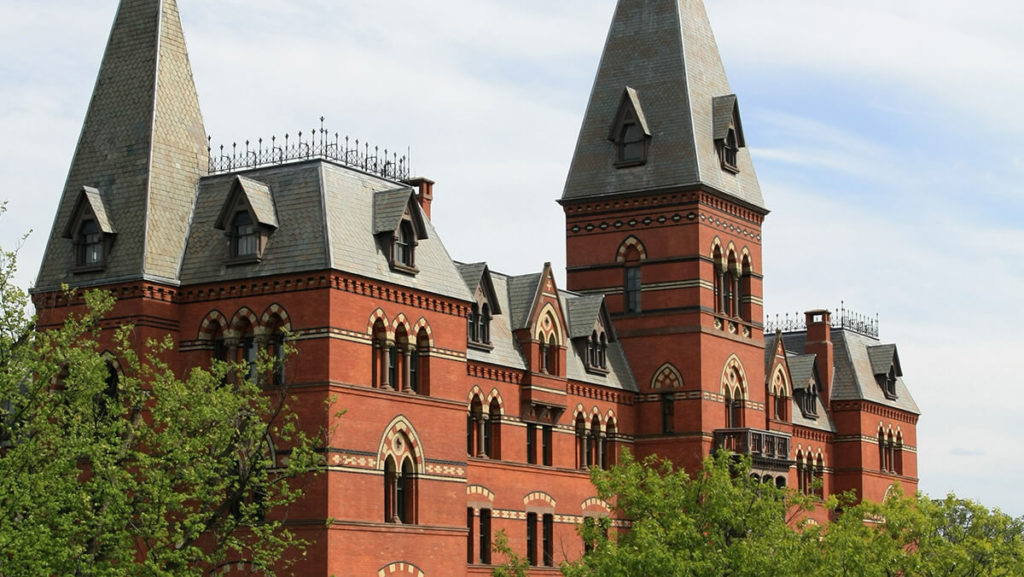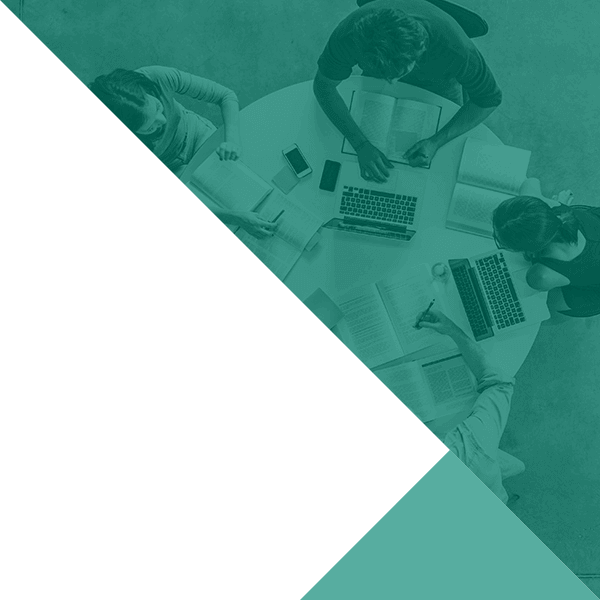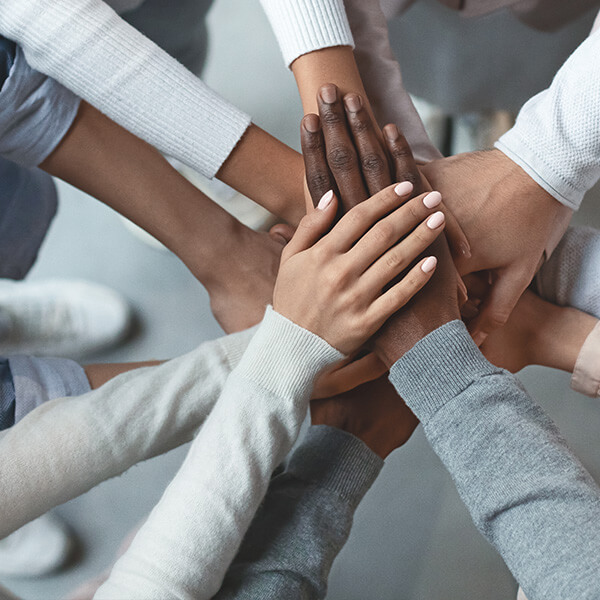1.0 Partnership Overview
The NY BID partnership was a new (Emerging) partnership at the onset of this project. Two collaborative staff positions, one in each institution were supported to establish, maintain and grow the partnership and to work through the opportunities and challenges that arise in emerging cross-institutional partnerships. To begin, a strategic position at Cornell in the Office of Sponsored Programs (OSP), under the leadership of the Vice Provost of Research was created. This was a deliberate choice to anchor a Broader Impacts Professional in a centralized university HUB, where all researchers/research administrators across the 15 schools and colleges would have access to Broader Impacts supports, services, partnerships and other resources s they were being developed to serve this community. The Sciencenter position was based in the education department and connected BID opportunities to museum leadership and education programs. Both the HEI and ISE staff members worked from the beginning of the partnership under the shared goal of moving the institutional structures toward more systematic, durable partnerships.
2.0 Reflections from the Partnership
In what ways did the partnership change the way you think about your own organization’s approach to BI or BI support? In what ways did individual PIs learn or improve their practice? How did you or your organization learn or improve your BI practice?
Through our ongoing work to elevate the quality and outcomes of Broader Impacts work in the community, we have discovered one quality that tends to result in better (and more apt to be funded!) community engagement initiatives: clear planning and thoughtfulness in the pre-proposal stage. At the Sciencenter, we provide myriad opportunities for researchers to engage with the public, such as working with our summer camps, engaging our middle school Future Science Leader program, developing outreach programs for rural audiences, or engaging with adults in the community to improve science literacy. As we strengthen our ties with the research administration community at Cornell, we have had more opportunities to engage with faculty in the pre-proposal stage, and assist with the development of their broader impacts work. At this early stage, without the pressure of a looming grant submission deadline, we can invite researchers to participate in our programming as a “trial run” for their later BI work, and to see what kinds of programming or topics might work best for both parties. These early opportunities allow researchers to collect “pilot data” for their BI work, which they can write into their proposals to strengthen their credibility both in their research, and within their chosen field of BI. We have streamlined our own side of the process with the help of a BI Menu. Since our end goal for this partnership is institutionalization on both sides, we prepared a menu with descriptions of the types of programming that we already offer that are good fits for researcher collaborations. Most crucially, our BI Menu includes prices. This allows for clear communication and concrete expectations for both sides when planning collaborative BI work. As the ISE, we can make sure that all proposed work fits into our mission and within our capacity, and the PI understands the true costs associated with this work, which often causes them to place higher value on the partnership.
How have you worked to understand each other? When did you struggle or fail to understand one another? How did you navigate the culture and language code-switching necessary to work across organizations? How did you establish clarity around goals, timelines and roles? How did you build trust within the partnership?
Our work together began with a shared desire to build a functional and durable relationship, where each organization had equal footing at the table, and could therefore bring benefits to both organizations. We had a common goal of creating shared processes and structures that would not only be beneficial in terms of streamlining interactions and partnerships across our organizations but to do so in ways that would be both nimble and sustainable for both organizations over the long-term. From the beginning, both organizations were able to envision some of the potential benefits to each organization, and we discovered additional benefits as we worked together. We were also able to anticipate some of the challenges that come with any partnership: the size, cultural and financial differences across our organizations are great, so issues of power, privilege, needs and capacity were likely to arise in our work together. Other challenges were impossible to anticipate: the complexity of personality differences, emergent project roles and responsibilities and staff change also challenged our partnership effectiveness at times. Having clearly articulated overarching goals gave us a strong foundation on which we could work through both the partnership opportunities and challenges. Regular communication, face-to-face interaction, shared work and shared decision making (empowerment) became the pillars for which trust and commitment developed across our team. In the early phase of our partnership, some project staff met daily, others weekly, and all of us came together monthly. Monthly meetings took place at both institutions, staff were provided orientation training at both institutions and had working days in the partner’s institutions as well. This allowed us to learn more about each other firsthand; our cultures, our strengths, our mandates, our stakeholders, timelines and competing responsibilities. For example, University researchers applying for NSF CAREER awards would reach out to the Sciencenter in early July for project development and letters of collaboration for mid-July grant submissions. At the same time Sciencenter staff were busy beginning the start of their summer camps programs and had limited capacity to work with researchers in project development. Neither organization was aware of the deadlines and competing priorities of the others. This awareness allowed all of us to shift our timelines ahead, by months in fact. As the partnership insights deepened, we continued to establish and refine shared goals and processes to better foster our work together. It took a year, and more, with dedicated staff engaged in deliberate and consistent communication, shared work, and ongoing interactions for our partnership work to become embedded in the organizations in ways that moved the work beyond the individuals directly involved in the partnership work. We had built trust and open communication across our team through this work as well, and that became critical in our ability to work together and not abandon the partnership when various challenges arose. We had established enough trust and commitment to the partnership to address the issues and figure out together how to manage certain roadblocks. Team meetings became a safe and necessary place to negotiate power dynamics, individual partner needs, and new directions for the partnership work.
Where have you encountered, and how have you dealt with, power imbalances within the partnership? These may be related to money (e.g. to hire help, dedicate time, general resources, or from NSF), organizational size, privilege, and/or positionality (i.e., where one sits in an organization and the amount of authority and agency they feel they have as a result).
Mission-driven organizations can feel bound to attempt every opportunity that might result in community engagement and betterment and bring in additional funding, but spreading ourselves too thin or spending resources on work that doesn’t fit our mission or play to our strengths can leave us further from reaching our goals. Part of our early work on this project involved the creation and subsequent use of a tool we have called an Institution Self-Inventory. This tool gives institutions a chance to reflect on their strengths and goals, and to think critically about what kinds of work fit best within a strategic framework to continue advancing those specific goals, while taking advantage of their strengths and resources in the community. Before the Sciencenter became involved in this grant, many of our interactions with researchers were fairly one-sided. Researchers would approach us with last-minute requests for letters of support for a grant due tomorrow (or sometimes, a grant that had already been submitted!). We would bend over backward to pull something together, only to find that the proposed work did not fit with our mission or current strategic plan, or that researcher had no intention of providing resources to implement the work. With our self-inventory completed, and our mission top of mind, we were able to make sure that partnerships with researchers were actually collaborative. We met with researchers early and often whenever possible, to help build programs that could advance our current work or mission-based goals. As a small institution, we cannot possibly partner with every researcher in town; nor would that lead to effective broader impacts work. The Institution Self-Inventory allowed us to actively pursue and build up partnerships that would be the most effective, and crucially, feel comfortable saying “no” when it was clear that a partnership would not be beneficial to our work. Recently, we received an email from a researcher, requesting a letter of collaboration. We enthusiastically suggested a time to sit down together and develop a plan for effective broader impacts work to benefit both parties, to which the researcher sheepishly replied that they did not have time to meet as the grant was due the following day. And we, emboldened by our clear sense of our mission, politely wished them luck in this funding round and invited them to reach out ahead of time if they would like to collaborate on developing their broader impacts for a future proposal. How liberating it can be to say no!
What indicators have you observed that the work is becoming institutionalized, through engagement of leadership, additional staff, succession planning, and new policies, procedures or routines that support sustained partnership? How have you navigated the balance between nurturing individual relationships with the desire to create systems/institutionalize? How has the team navigated the issues that arise from job changes and turnover?
One of the key goals of this grant was promoting institutionalization of partnerships — meaning building partnerships that are embedded and persistent at an institutional level, and not tied to the presence or absence of specific people at an institution. The museum/informal education field (and to a lesser extent non-tenured academia), often exhibits high staff turnover, an issue that is exacerbated in a small town like Ithaca. Though this project was short term, our small team has experienced multiple dramatic job changes, both within the institution and externally. Michelle Kortenaar, the PI on this project, originally held the title of Director of Education. In the span of two years, she has transitioned jobs within the Sciencenter twice, first to VP of Strategic Development, and most recently to Executive Director. In our experience, we found that this partnership needs a dedicated person involved in the program delivery to help with the coordination of researchers’ BI efforts. During the span of this project, the Sciencenter also experienced staff turnover in this role, with the original Education Program Coordinator leaving shortly after the first year. The new Education Program Coordinator, hired just over a year into the project, hit the ground running, but had a steep learning curve and tested the ability of this partnership to withstand turnover. Because we had funding and a commitment to this partnership, the institutions had an incentive to prioritize partnership even through turmoil. In fact, we found we were able to navigate these changes quite successfully, due to one key decision: we maintained regular meetings. The entire team, from both the HEI and the ISE, continued monthly in-person meetings, even when it seemed there wasn’t anything new to discuss. The ISE side had weekly internal meetings, as well as weekly check-ins with the BI Manager at the HEI. And the HEI BI Manager and the ISE Program Coordinator, the positions with the most time dedicated to this project and to interfacing with researchers, met at least once per week but often more frequently to make sure we were all advancing work to the benefit of both institutions.
Under what circumstances (and in what ways) has the partnership decided to expand the scope of the work? Where have you adjusted or adapted to ensure the partnership work aligns with shifting organizational goals or capacity? How have you embraced reflective practice and in what ways has it supported adaptability?
Even with consistent team meetings, goal setting and shared tasks and deliverables, we came to discover at the end of year one, and for some time after, that our ultimate vision for the two organization partnership was, and perhaps remains, somewhat divergent. This makes sense because our institutions each have unique missions, stakeholders and resources to carry these out. From that vantage point, we hit some roadblocks, and experienced standstill and frustration at times across our partnership. In hindsight, this seems to be connected with the fact that we implicitly had different overall outcomes in mind for how the partnership would benefit our individual institutions. The self-inventory discussion process was amiss in the beginning of our partnership formation, partly because we didn’t have the specific tool, and partly because we assumed we were all on the same page because we shared and discussed a three year project timeline and narrative for the work. After a year and a half into the partnership we revisited the self-inventory tool, and began to discuss more openly how the aims and needs of the HEI partners were not on the table so to speak, and when they were, they were often viewed as beyond the scope of what we could do together, and in some ways the ISE partners perceived these interests as a threat to the two-organization partnership. The HEI staff partners assumed from the beginning that the in-depth and intentional nature of the two-organization partnership was ultimately a learning testbed from which we would together create and assess news ways and means to form university-community partnerships more broadly, more efficiently and more sustainably. By working together we assumed that the collective learning could then be used by both parties to grow and implement new partnerships and that partnerships could be implemented in either direction. HEI staff could use tools and new structures to bring new community partners into the BID process, and ISE staff could do that same with relevant HEI partners, like Public Service Center, Office of Engagement, K-12 outreach and more. From the beginning, there has always been a bit of a mismatch, of both size and mission, between the two organizations in our partnership. In 2019 Cornell’s NSF research expenditures were $115.5 million. The Sciencenter total annual expenditures were? , Certainly, it would be impossible for all of those researchers to partner with the Sciencenter for their broader impacts, and many would not be a good fit for broader impacts collaboration with the Sciencenter based on their own interests and experience. The Cornell side of the team was eager to expand this model to additional partners, as they saw this as a great opportunity to serve more researchers and elevate broader impacts more widely, but the Sciencenter was a bit more hesitant. While it’s true that we could not partner with every Cornell researcher seeking NSF funding, we were afraid of losing this funding source ourselves if researchers went elsewhere. Additionally, the Sciencenter is well-known to the community as a children’s museum, but many may not know that we also provide programming for adults, middle school students, and rural communities. Without an incentive for the HEI to promote partnerships with the Sciencenter, we feared that fewer researchers would meet with us, fewer researchers would discover collaborative interests with us, and ultimately, fewer researchers would write us into grant proposals. After much deliberation and negotiation, and learning a lot about the differing organizational timelines, needs and priorities, we came to trust that our two-organization partnership was robust and embedded enough into our processes, that we could begin to pilot opening up to a wider circle of partners. We decided together to bring in a small subset of community institutions that would expand the range of Broader Impacts partnerships beyond the ISE setting. We invited Cornell Cooperative Extension, Ithaca Children’s Garden, WSKG Public Media, the local community college, CollegeNow program for high school STEM teachers and two non-profit STEM organizations, Community Science Institute (Water Quality and Citizen Science) and Discover Cayuga Lake. We did this in partnership with the Cornell Public Service Center as well. We brought everyone together for two days of workshop activities and discussion under the belief that “a rising tide lifts all boats.” Going it alone, harboring and protecting what we had learned for the sole benefit of our single partnership would not foster the kind of sustainability to our work that a network or seasoned practitioners might provide. It was risky in a sense, to move away from competition and toward cooperation and expansion, especially when many small, non-profit organizations feel like they are competing for the same small pool of community funds. Our two-organization partnership came to grow together, through the growing pains and toward a larger vision for our work, where perhaps together, community organizations could ban together, learn from one another, and form a unified front, and approach to supporting and shaping the Broader Impacts mandates and requests coming from the HEI community. We wondered, what might happen to the quality of BI work in our community, if all community partners advocated for their organizational interests, and needs, and were in positions where they felt empowered to ensure that appropriate resources would be allocated to them, for their contributions, involvement and expertise? Ultimately, our two-organization partnership grew through success and difficulty, and towards the creation and support of a network of partners where, we hope, might lead us to a better place where more HEI researchers and community organizations benefit from the formation of more deliberate Broader Impacts partnerships; where everyone speaks the language of BI and understands the drivers and opportunities within Broader Impacts partnerships, and enters into them on equitable footing and with sustainability in mind.



